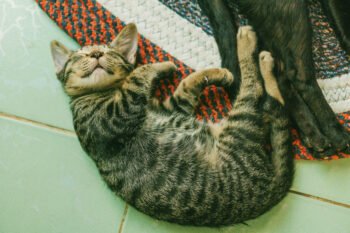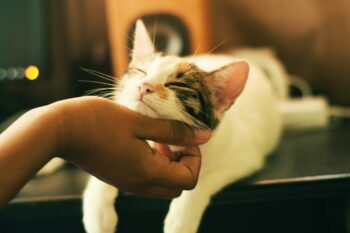Every cat owner knows the benefits of petting a cat. It’s relaxing, the stresses of the day disappear, the blood pressure drops and the heart rate slows. Therapy cats provide this relaxation — and much more — to people who are shut in, lonely, sick, or troubled. A visit from a therapy cat and her owner is a break in the daily routine for people living in a care facility — always a welcome treat. And a cat provides a kind of love and comfort that only comes from pets.
I began making therapy cat visits with my brown tabby, Flea, a cat who had been abandoned at the veterinary hospital where I worked. Flea was a very calm cat. He never panicked when startled, and was very affectionate.
Therapy cat owners say the most important traits for a therapy cat include a laid-back, steady, calm personality and a tolerance for the unusual. A cat who reacts before thinking is not a good therapy cat. Therapy cats must be able to tolerate sights and sounds that are unusual, petting that could be different or a bit rough, poking or pulling, and any number of other things that are out of the ordinary. Therapy cats are also affectionate, purring, snuggling on a lap or on the bed, or offering other gestures of affection.
A therapy cat also needs to be up-to-date on his vaccinations and very healthy, so he isn’t a danger to people with impaired immune systems. A visit to the vet is a good idea.
When I decided to begin making therapy visits with Flea, I began by introducing him to a figure-eight harness. When I put the harness on him, I gave him a favorite treat so that he would associate the harness with something good. When he started wearing the harness without too much fuss, I attached a lightweight leash and let him drag it. Again, I gave him some special treats and lots of petting when he wore the harness and leash.
To get Flea used to the idea of going for a visit, I began by going through the motions of getting ready. I got dressed, brushed Flea well, made sure his nails were trimmed, put on his harness and put him in his cat carrier. (Flea had already been introduced to a cat carrier and rode in one very nicely, so that wasn’t a problem.) I then drove over to my parents’ house. We went in and I placed Flea on my Dad’s lap. Flea jumped down right away, so I gave my Dad some of Flea’s treats and told him to offer Flea a treat only when Flea held still for petting. It took Flea about 15 seconds to learn that lesson, and he settled down on my Dad’s lap and stayed there even after the treats were gone.
Over the next several weeks, I repeated this same exercise at every friend’s home I could convince to cooperate. Eventually, Flea was so casual and relaxed about the whole process that I called the Alzheimer’s facility where my dogs and I visited regularly and asked if I could bring a cat the next time. The response was very positive, and the activities director said she would make up a list of residents who liked cats.
When we walked into the first room, I took Flea out of his carrier and introduced him to the resident, “Grace, this is Flea, a shorthaired cat. Would you like to pet him?” When she smiled and nodded, I put Flea on the bed next to her and as she began petting him, he began to purr. I relaxed across the room from her and I have to admit, as I watched Flea knead the bedclothes of this frail, white-haired, elderly lady, and she smiled as she pet the cat, I had tears in my eyes!
When you first take your therapy cat for a visit, have a hankie ready because you’ll need it. Even now, after 16 years, when I go on visits, I still cry sometimes.
When Flea was 12 years old and beginning to show his age, I started making his visits shorter and less frequent. On one visit to the local Alzheimer’s facility, we stopped in to see a resident who had become a friend over the years. Margie was in bed and her family was in her room. Apparently during the night Margie had a stroke, and the family was with her because she wasn’t expected to live through the day. I apologized for intruding and started to back out of the room, when Margie’s daughter saw and Flea and asked, “Is that the cat Mom’s been telling us about?” When I said yes, they asked me to please let Flea visit, so I placed Flea on the bed next to Margie.
Flea walked up the bed, put his body next to Margie’s and snuggled into her armpit. He them began to knead and purr. She turned her head toward him, without opening her eyes, and smiled. She then took a deep breath and passed away.
We, as pet owners, know how much love and trust our pets give us. But when we can share that love, and when we see people benefit from that love, it’s an amazing gift.
The Foundation for Pet Provided Therapy and the Delta Society both certify cats as therapy pets. Each has their own requirements for certification, so send a self-addressed stamped envelope to each for more information: Foundation for Pet Provided Therapy
The Delta Society
For a list of links to many pet therapy groups, go to: |







